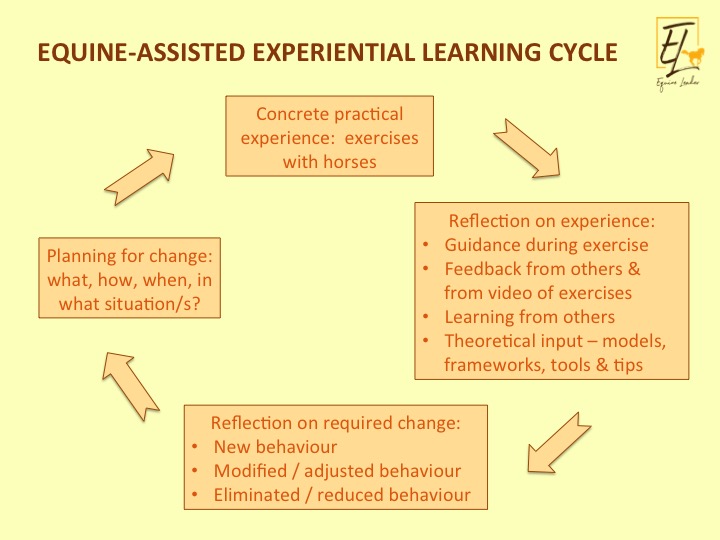WHAT exactly is equine-assisted experiential learning?
Equine-assisted experiential learning (EAEL) is a form of experiential learning which uses exercises carried out with horses as the ‘experience’ element of the learning process. It is particularly useful to help build and develop many of the skills and competences which are related to the four pillars of emotional intelligence.
Experiential learning is a process in which a concrete practical experience provides data which the learner can reflect on to get insights into his or her behaviour. These reflections allow the learner to think about what new or different behaviour is needed in order to get different results. This new behaviour can then be practised in a second practical experience, providing more data to reflect on. This cycle is repeated until the new behaviour is consistently performed immediately and without conscious thought or effort whenever required.
Using exercises with horses as the concrete practical experience provides an opportunity to gather data about the impact of non-verbal communication, and how it is affected by emotions, confidence, focus, trust and other aspects of internal state.
The exercises are done from the ground, without riding the horse. The basic premise of the exercises is for the participant to get the horse to move around the arena without touching it; there are many variations, including the use of obstacles such as poles on the ground, or tools like a lead rope or a long whip. Sometimes exercises involve one person and one horse, but they can also involve several people and/or horses. The type of exercise used depends on the specific needs and objectives of the participant or participants.
During the exercises, the facilitator provides guidance and structure by asking coaching-type questions to raise the participant’s awareness of how his or her inner state is affecting the horse’s behaviour. Additional guidance may be provided by feedback from or observation of fellow participants, as well as by a video of the exercises.
To help the participant reflect on what aspects of behaviour need to change in order to have a different impact in different situations, the exercises with the horses are supplemented with theoretical input in the form of models, frameworks, tools and tips etc. Using all the information available, the participant can plan how to change his or her behaviour, and apply these changes in a second round of exercises with the horses. In subsequent rounds of the learning cycle, exercises with horses will be replaced by situations with people in the real professional context of each participant.
The cycle of equine-assisted experiential learning is based on David Kolb’s model of experiential learning.
Equine-assisted experiential learning is especially helpful in the development of the four key pillars of emotional intelligence: self-awareness, self-management, social awareness and relationship management.
Today, with the increased efficiency of technology and the resulting ease of access to information whenever and wherever we choose, learners are increasingly looking to micro-learning solutions – short, focused information sessions providing immediate answers to work-related questions or problems solutions. However, long-term changes in attitude and related behaviours still require macro-learning – a structured process of learning over time in order to bring about unconscious competence in a selected behaviour or skill.
Changing behaviours that are related to emotions, and which may stem from deep-seated beliefs, values and often-unconscious assumptions, takes time and effort. A short stand-alone training course, workshop or information session will not provide the structured guidance and support of the learning process that is necessary to embed such behaviours. In addition, in order to change behaviours related to emotional intelligence, it is important to provide opportunities for learning by doing in which participants can experience genuine emotional reactions in a safe environment – one in which mistakes or failure will not have potentially serious consequences, either personally or professionally.
Doing exercises with horses provides just such a safe environment, allowing participants to work on concepts like trust, congruent communication, self-confidence and assertiveness without potential negative personal or professional consequences.
WHAT does an EAEL programme look like?
We design and run programmes for individuals, working teams, or groups, with a recommended ratio of 1 equine-assisted learning facilitator to a maximum of 10 participants.
A typical EAEL programme runs for 3 – 6 months, and includes at least two sessions of exercises with the horses, some group classroom sessions, and up to four individual coaching sessions with each participant. This format allows for the effort over time required for behavioural change to be adjusted and assimilated, and start to become unconscious.
Typically, the sessions with the horses are between a half and a full day, depending on the number of participants in the group. Group classroom sessions, which cover theoretical input and related discussion, last 2- 3 hours, and individual coaching sessions are between 30 minutes and 1 hour each. Only the sessions with the horses require the participants to be physically present – all other sessions can be run virtually if required. That said, it is strongly recommended that at least the first, if not all, of the group sessions are run with participants physically present. This helps to build a relationship of trust within the group and facilitate the peer feedback and support which are an integral part of a sustainable development process.
Equine-assisted experiential learning can also be incorporated into an existing development activity, such as a leadership development programme, or an individual or team coaching process. In these cases, only one round of the experiential learning cycle includes exercises with horses as the experience element; in subsequent rounds, the new behaviour is applied in relevant professional situations selected or designed by the programme leader or coach.
